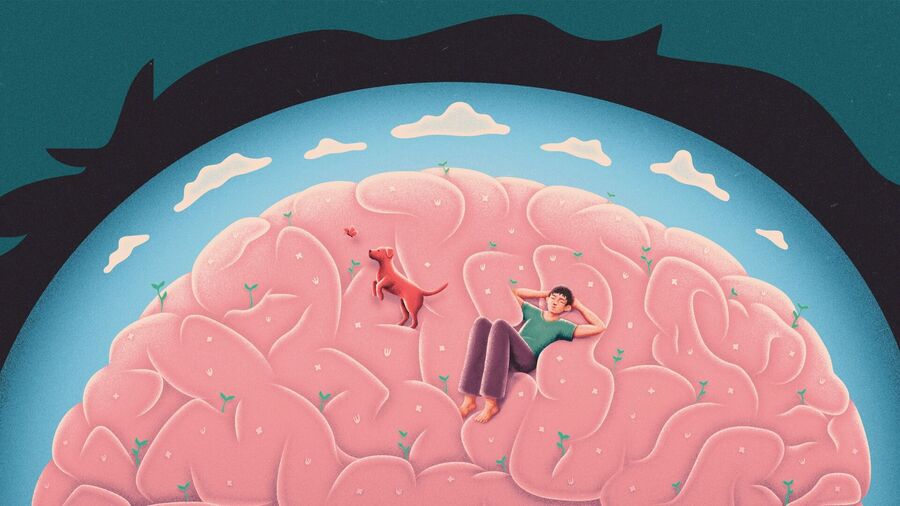The answer, researchers have found, is yes. Over the past two decades they've defined what's known as the default mode network, a collection of seemingly unrelated areas of the brain that activate when you're not doing much at all. Its discovery has offered insights into how the brain functions outside of well-defined tasks and has also prompted research into the role of brain networks — not just brain regions — in managing our internal experience.
In the late 20th century, neuroscientists began using new techniques to take images of people's brains as they performed tasks in scanning machines. As expected, activity in certain brain areas increased during tasks — and to the researchers' surprise, activity in other brain areas declined simultaneously. The neuroscientists were intrigued that during a wide variety of tasks, the very same brain areas consistently dialed back their activity.
It was as if these areas had been active when the person wasn't doing anything, and then turned off when the mind had to concentrate on something external.
Researchers called these areas "task negative." When they were first identified, Marcus Raichle, a neurologist at the Washington University School of Medicine in St. Louis, suspected that these task-negative areas play an important role in the resting mind. "This raised the question of 'What's baseline brain activity?'" Raichle recalled. In an experiment, he asked people in scanners to close their eyes and simply let their minds wander while he measured their brain activity.
He found that during rest, when we turn mentally inward, task-negative areas use more energy than the rest of the brain. In a 2001 paper, he dubbed this activity "a default mode of brain function." Two years later, after generating higher-resolution data, a team from the Stanford University School of Medicine discovered that this task-negative activity defines a coherent network of interacting brain regions, which they called the default mode network.
The discovery of the default mode network ignited curiosity among neuroscientists about what the brain is doing in the absence of an outward-focused task. Although some researchers believed that the network's main function was to generate our experience of mind wandering or daydreaming, there were plenty of other conjectures. Maybe it controlled streams of consciousness or activated memories of past experiences. And dysfunction in the default mode network was floated as a potential feature of nearly every psychiatric and neurological disorder, including depression, schizophrenia and Alzheimer's disease.
Since then, a flurry of research into the default mode has complicated that initial understanding. "It's been very interesting to see the types of different tasks and paradigms that engage the default mode network in the last 20 years," said Lucina Uddin, a neuroscientist at the University of California, Los Angeles.
The default mode was one of the first brain networks characterized by science. It consists of a handful of brain regions, including a few at the front of the brain, like the dorsal and ventral medial prefrontal cortices, and others scattered throughout the organ, like the posterior cingulate cortex, the precuneus and the angular gyrus. These regions are associated with memory, experience replay, prediction, action consideration, reward/punishment and information integration. (The colored highlighting in the following figure indicates some of the outer brain areas that become more active when the default network engages.)

According to research, the effects of the default mode network include mind wandering, remembering past experiences, thinking about others' mental states, envisioning the future and processing language. While this may seem like a grab bag of unrelated aspects of cognition, Vinod Menon, the director of the Stanford Cognitive & Systems Neuroscience Laboratory, recently theorized that all of these functions may be helpful in constructing an internal narrative. In his view, the default mode network helps you think about who you are in relation to others, recall your past experiences and then wrap up all of that into a coherent self-narrative.

Uddin began investigating the default mode network because she was interested in self-recognition, and many self-recognition tasks, such as identifying your own face or voice, appeared to be associated with the network. In recent years, she has shifted her attention to interactions between brain networks. Just as different brain areas interact with each other to form networks, different networks interact with each other in meaningful ways, Uddin said. "Network interactions are more elucidating to study in some ways than just a network in isolation because they do work together and then come apart and then change what they're doing over time."

Researchers have also been examining whether mental health disorders like depression could be linked to problems with the default mode network. So far, the findings have been inconclusive. In people with depression, for example, some researchers have found that network nodes are overly connected, while others have found the opposite — that nodes are failing to connect. And in some studies, the default mode network itself isn't abnormal, but its interactions with other networks are. These findings may appear incompatible, but they align with recent findings that depression is perhaps a cluster of different disorders that present with similar symptoms.
Meanwhile, Menon has developed what he calls the triple network theory. It posits that abnormal interactions between the default mode network, the salience network and a third one called the frontoparietal network could contribute to mental health disorders including schizophrenia, depression, anxiety, dementia and autism. Typically, the activity of the default mode network decreases when someone is paying attention to an external stimulus, while activity in the two other networks increases. This push and pull between networks may not work the same way in people with psychiatric or developmental disorders, Menon suspects.
Deanna Barch, who studies the neurobiology of mental illnesses at Washington University in St. Louis, is intrigued by the triple network theory. Investigating how networks are wired up differently in people with mental health disorders can help researchers find underlying mechanisms and develop treatments, she said. However, she doesn't think network interactions alone will fully explain mental illness. "I think of understanding connectivity differences as a starting point," Barch said. "It's not an endpoint."
The current understanding of the default mode network is surely not its endpoint, either. Since its discovery, it has pushed neuroscientists to think beyond the responsibilities of single brain regions to the effects of interactions between brain networks. And it's driven many people to appreciate the inward-focused activities of the mind — that even when we're daydreaming or at rest, our brain is hard at work making it happen.
Nora Bradford is a freelance science writer and a graduate student in cognitive science at the University of California, Irvine. Her work has appeared in Scientific American, Science News, Discover, and other outlets.




Reader Comments
Good grant money for 'mindless' work LOL!!
And in the thoroughly indoctrinated, discard all information that conflicts with the axioms of the implanted narrative.